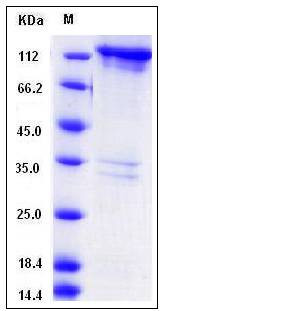Human MARK3 / CTAK1 / EMK-2 Protein (His & GST Tag)
CTAK1,KP78,Par-1a,PAR1A
- 100ug (NPP1648) Please inquiry
| Catalog Number | P12181-H20B |
|---|---|
| Organism Species | Human |
| Host | Baculovirus-Insect Cells |
| Synonyms | CTAK1,KP78,Par-1a,PAR1A |
| Molecular Weight | The recombinant human MARK3/GST chimera consists of 967 amino acids and has a calculated molecular mass of 109.3 kDa. It migrates as an approximately 120 kDa band in SDS-PAGE under reducing conditions. |
| predicted N | Met |
| SDS-PAGE |  |
| Purity | > 88 % as determined by SDS-PAGE |
| Protein Construction | A DNA sequence encoding full length of human MARK3 (AAH24773.1) (Met 1-Leu 729) was fused with the N-terminal polyhistidine-tagged GST tag at the N-terminus. |
| Bio-activity | The specific activity was determined to be 7 nmol/min/mg using synthetic CHKtide peptide (KKKVSRSGLYRSPSMPENLNRPR) as substrate. |
| Research Area | Cancer |Cancer immunology |Cytokine & Receptor |Interleukin & Receptor |IL-1 family & Receptor |IL-1 Family Signaling Molecules | |
| Formulation | Supplied as sterile 20mM Tris, 500mM NaCl, 0.25mM DTT, 0.1mM PMSF, 0.1mM EDTA, pH 7.4, 10% gly 1. Normally 5 % - 8 % trehalose and mannitol are added as protectants before lyophilization. Specific concentrations are included in the hardcopy of COA. |
| Background | MAP / microtubule affinity-regulating kinase 3, also known as C-TAK1, cTAK1, Cdc25C-associated protein kinase 1, ELKL motif kinase 2, Protein kinase STK10, Ser/Thr protein kinase PAR-1, Serine/threonine-protein kinase p78, MARK3, CTAK1 and EMK2, is a ubiquitous expressed protein which belongs to the protein kinase superfamily, CAMK Ser / Thr protein kinase family and MARK subfamily. MARK3 contains one KA1 (kinase-associated) domain, one protein kinase domain and one UBA domain. The Par-1 / MARK protein kinases play a pivotal role in establishing cellular polarity. This family of kinases contains a unique domain architecture, in which a ubiquitin-associated (UBA) domain is located C-terminal to the kinase domain. MARKs / PAR-1 are common regulators of cell polarity that are conserved from nematode to human. All of these kinases have a highly conserved C-terminal domain, which is termed the kinase-associated domain 1 (KA1). |
| Reference |
